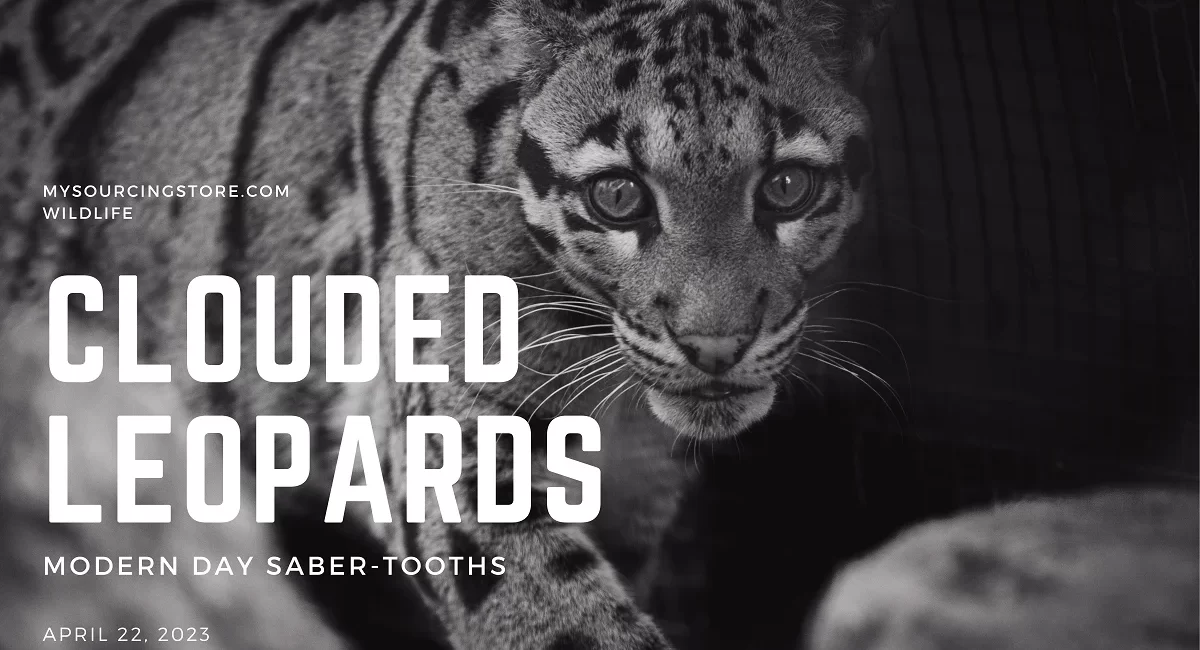Clouded Leopards: Modern Day Saber-Tooths
Clouded leopards are one of the most enigmatic big cats in the world. With their striking coat patterns, long tails, and sharp teeth, they are often described as the modern-day saber-toothed cats. In this article, we will explore the physical characteristics, behavior, habitat, conservation status, and future outlook of clouded leopards.
Physical Characteristics
Clouded leopards are medium-sized cats, weighing between 11 to 23 kg (24 to 50 lbs) and measuring between 61 to 110 cm (2 to 3.6 ft) in length. They have a distinctive coat pattern that resembles a cloud or a marble, which provides excellent camouflage in their forested habitats. Their paws are large and flexible, allowing them to climb trees and descend headfirst. They also have long canine teeth that are longer than those of any other feline relative to their skull size.
Habitat and Distribution
Clouded leopards are found in Southeast Asia, including Nepal, Bhutan, India, Bangladesh, Myanmar, Thailand, Cambodia, Laos, Vietnam, and Malaysia. They prefer dense forest habitats, including tropical and subtropical evergreen forests, secondary forests, and logged forests. Unfortunately, their habitat is rapidly shrinking due to deforestation and fragmentation, putting them at risk of extinction.
Behavior and Lifestyle
Clouded leopards are solitary and elusive animals, making them challenging to study. They are mainly nocturnal, and their diet includes small mammals, birds, reptiles, and occasionally larger prey such as deer and monkeys. They are excellent climbers and can even hang upside down from branches. They are also known for their unique vocalizations, which range from growls to high-pitched calls.
Conservation Status
Clouded leopards are listed as Vulnerable on the IUCN Red List, with an estimated population of fewer than 10,000 individuals. They are threatened by habitat loss, poaching for their skin and bones, and the illegal wildlife trade. Several conservation organizations are working to protect clouded leopards and their habitat, including Panthera, the Clouded Leopard Project, and the Clouded Leopard Conservation Fund.
Comparing to Saber-Toothed Cats
While clouded leopards are often compared to saber-toothed cats, they are not closely related. Saber-toothed cats belong to the extinct family Felidae, while clouded leopards are part of the living family Felidae. Saber-toothed cats also had much longer canine teeth, up to 28 cm (11 in) in some species, compared to the 4 cm (1.6 in) canines of clouded leopards. However, both species share adaptations for hunting and killing prey, including sharp teeth and claws.
Threats to Clouded Leopards
The main threats to clouded leopard survival are habitat loss and fragmentation due to deforestation and land conversion for agriculture and development. Poaching for their skin and bones, as well as the illegal wildlife trade, are also significant threats. Climate change is another emerging threat that could impact their habitat and prey availability.
Conservation Efforts
Several conservation organizations are working to protect clouded leopards and their habitat, including Panthera, the Clouded Leopard Project, and the Clouded Leopard Conservation Fund. Community involvement is essential for successful conservation efforts, as local people can provide critical information and support for conservation initiatives. Zoos and captive breeding programs are also playing a crucial role in preserving the genetic diversity of clouded leopards.
The Future of Clouded Leopards
The future of clouded leopards is uncertain, but there is hope for their survival. Continued conservation efforts, such as habitat restoration and anti-poaching initiatives, can help to stabilize and increase their populations. Additionally, educating the public about the importance of preserving biodiversity and the role of clouded leopards in their ecosystems can also contribute to their conservation.
Overall, clouded leopards are fascinating and important animals that deserve our attention and protection. While they may not be true saber-toothed cats, they are still impressive predators with unique adaptations for survival in their forested habitats. By working together to conserve their populations and their habitats, we can help to ensure that these modern-day saber-tooths continue to roam the forests of Southeast Asia for generations to come.
What is their Prey
Clouded leopards are carnivorous and feed on a variety of prey, including deer, birds, rodents, and monkeys. They are excellent climbers and are known to hunt in trees, where they can catch their prey off guard. The clouded leopard’s strong jaws and sharp teeth enable it to kill its prey quickly and efficiently. They are also known to hunt on the ground and can take down prey larger than themselves. The clouded leopard’s diet varies depending on their location and the availability of prey. In some areas, they may feed on smaller prey such as squirrels and rodents, while in others, they may hunt larger prey such as deer and wild pigs.
FAQS
- Are clouded leopards dangerous to humans?
- Clouded leopards are generally not considered a threat to humans, as they are solitary and elusive animals that avoid contact with people.
- Can clouded leopards be kept as pets?
- No, it is illegal to keep clouded leopards as pets, as they are protected under various national and international laws.
- What is the lifespan of a clouded leopard in the wild?
- The lifespan of a clouded leopard in the wild is estimated to be around 11 years, although they can live up to 17 years in captivity.
- How many subspecies of clouded leopards are there?
- There are currently two recognized subspecies of clouded leopards: the mainland clouded leopard (Neofelis nebulosa) and the Sunda clouded leopard (Neofelis diardi).
- How can I help protect clouded leopards?
- You can help protect clouded leopards by supporting conservation organizations, avoiding products made from endangered species, and spreading awareness about their conservation status and threats.
Photo by Alotrobo




Leave a Comment